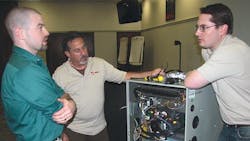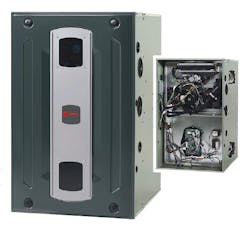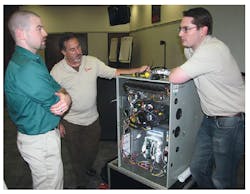When you have a product that’s been around for 25 years and is well regarded by homeowners, dealers, distributors and even competitors, you had better make sure you have an outstanding product when it comes time to roll out the next generation model.
That was the challenge that Trane faced two years ago when its parent company, Ingersoll Rand, sought to remake its popular furnace line and develop the new S-Series Furnace platform. The current furnace platform was launched in 1991, and is still regarded as one of the best-designed products in the residential furnace industry. Even though the furnace is well known for reliability and durability, it was falling behind the curve in some of the performance and application metrics. The challenge for the design team was to keep the DNA of the furnace, but bring it up to date with today’s performance standards.
“Literally the first requirement I wrote when writing the requirements for the new furnace was ‘don’t screw it up’ because we already have a great product,” says Jim Lowell, furnace product manager for Ingersoll Rand. “We wanted to make sure we carried over the DNA from the legacy platform for the reliability and durability that it is known for.”
What Lowell and his team came up with was the S-Series Furnace. Introduced in December, the S-Series began shipping through its distribution channel in January and has already received acclaim from customers and the industry. “The feedback has been really tremendous,” he says. “I think we’ve got absolutely the right product.”
Because this new Trane furnace would be something new for the design and engineering team, they decided that they would break new ground in how the furnace would be designed and developed when they began work in early 2014. The first step was to extend the scope of the team. “We broke down silos for this and collaborated with other product platform teams on the design,” Lowell says. “We picked cross-functional collaborators and together improved the product that we ultimately delivered quite a bit.”
But Lowell wanted to further extend this collaboration beyond the engineering teams so he brought in a mix of HVAC dealers to collaborate with them. “We chose 12 gentlemen from 12 different dealerships across North America,” Lowell says. These 12 formed the Next Generation Furnace Dealer Council and, over the next 18 months, they would play an instrumental role in how the new furnace would look, function and operate.
Lowell made it very clear to the members of the dealer council that they were not brought in to rubber stamp the work of the engineering team. “The charge I gave them was you’re not here to approve the designs we came up with. You are here to design this new product. You 12 are just as responsible to this design as our engineers are,” he recalls telling them. “We picked the right 12 people. They took this charge very, very seriously.”
Bringing in 12 dealers who were asked to be “painfully honest” and open was a risk, but Lowell says their experiences working with homeowner customers in selling furnaces as well as installing and servicing them proved to be an invaluable part of the process. “They brought knowledge and experience into the design team that we never would have received otherwise,” he says.
Working with dealers to design a new furnace was a first for this team, but Lowell says it was consistent with the company’s strategy to work as partners with their dealer and distributors as part of its commitment to two step distribution.
There are about 14,000 dealers across North America who carry the Trane line of products. Multiply that by the technicians and salespeople who work for these dealers and you have a huge number of people to inform and educate. “That’s where our distributors for Trane come in and add value to the distribution process,” Lowell says. “They are closer to their dealers, closer to their customers than we could ever be as a manufacturer.”
There are about 100 Trane distributors across North America. “One advantage of having that distribution model is communication. We can communicate with a relatively small number of distributors and they can get that information out to dealers more effectively,” he adds.
Ingersoll Rand at a Glance- Trane Variable Speed Air Conditioners, Heat Pumps and Air Handlers
- Trane S-Series Furnace
- Nexia smart home systems
- CleanEffects Air Cleaner
As the engineers and dealer council worked together to design the new furnace, a major focus for the dealers was making it as easy as possible for technicians to install and service the product. As furnaces have become more efficient and compact, manufacturers have had to fit more technology into a smaller box. That has, in turn, made the equipment more difficult to install and service. With this challenge came an opportunity to remake a Trane furnace into something that could be a true differentiator in the industry.
One area that the team was able to simplify was the integrated furnace control. The DiP switch was replaced with an intuitive alphanumeric LED readout with a menu option. “Now instead of setting DiP switches, you simply hit a menu button,” Lowell says. While the new S-Series furnaces are not the first to use this menu, what makes them stand out is their ability to provide real-time status for the furnace at all times, including read outs of the fault codes. “The alphanumeric readout tells you exactly what the fault is. That’s much more than what a flashing light could ever tell you,” Lowell adds.
Throughout the design process, the dealer council used an installation service scorecard to evaluate all aspects of the furnace. Lowell acknowledges that the scores for the S-Series early in the process were not good when matched against competitive products. “But we made changes over time in terms of service and we moved up to first place,” he says. “Now we have something there we could measure and, according to the council, it’s the easiest to service and install among competitors.”
One area of concern for one dealer in particular was the ease of taking out a blower from the furnace in order to inspect and clean it, which is typically part of a service call. Lowell recalls this dealer putting the furnace prototype on its side in a conference room and laying down next to it to simulate what a technician would do when the furnace is in a tight space in an attic. “He was really watching out for the dealer who has to deal with that in an application,” Lowell says.
Another dealer from the Pacific Northwest was particularly concerned with downflow issues, more common in this region of the country, when air is blown down into the ductwork underneath the floor of the house. The challenge here was how to properly vent the furnace so it could have the same venting options as an upflow furnace. “We might not have given this issue that much focus if he hadn’t been such a vocal advocate,” Lowell says. The S-Series Furnace can be used for downflow right out of the box with no conversion necessary, which gives dealers greater flexibility in using this product in different applications.
There were a number of “a-ha” moments when dealers would talk about real-life issues they had faced and the engineers would fashion solutions that addressed them. Among the issues that engineers hadn’t thought about was the aesthetics of the furnace. For homeowners with finished basements where the furnace is exposed, they wanted something that looked nice. “Aesthetics was something that we never really focused on before, but we took that to heart,” Lowell says.
While the homeowner is the ultimate customer of a Trane furnace, in this case, the company targeted the dealers as its primary customers. “When it comes to features of the furnace, we have homeowner-geared features like comfort, efficiency, quiet operation and reliability. But there are a whole lot of new features that are dealer-oriented,” Lowell says. “We really want to make sure the message gets out to dealers directly and that’s where we use our distribution channel to cascade the Trane knowledge about the new product.”
Last fall, Lowell and Kenny Davenport, a furnace product specialist, traveled to distributors across much of the U.S. to train its customers on the S-Series as part of a “train-the-trainer” approach. “That’s the most efficient way to get the message out to a very large distribution channel as quickly as possible, and we’ll continue to do that in 2016.”
This focus on the dealers is so important because they are the ones who sit across from homeowners at the kitchen table and guide them in selecting the right furnace for their home. “When they trust their contractor, homeowners will, the vast majority of the time, go with the product that their contractor recommends,” Lowell says. “I want the contractor to recommend our new furnace, and if he has a furnace that he wants to install and service, they’ll want to recommend us to his customer.”
The cross-functional team of engineers that worked together on the project is a best practice that Lowell plans to use on future new product projects. This approach, he says, changes the paradigm of thinking about products as individual parts and instead puts the focus on creating total functioning systems. In the past, he says, each engineering team may have focused on optimizing the performance of its individual function, which creates a system that is ultimately sub-optimized.
Best PracticesThe Collaborative Approach
Collaboration on the S-Series Furnace meant breaking down silos and bringing together teams of people who may not have normally worked together in developing new products. Jim Lowell said this approach created a much more highly functioning system because each team was thinking about the “system” rather than their “product.” Here are the teams that came together to develop the S-Series Furnace:
- AC Heat Pump Engineers: Provided detailed requirements of airflow and blower motor power consumption that enabled the AC/ HP system to hit current and future system SEER, EER and HSPF levels.
- Coil Team Designers: Their role was to optimize the airflow and coil interaction to provide our dealers and homeowners with the most comfortable/ cost efficient system possible.
- Manufacturing Engineers: This team helped to ensure that the final product was easy to assemble correctly and that our quality processes and end-of-line tests could catch any possible error.
- Furnace Engineers & Gas Lab Technicians: This team did the brunt of the mechanical, gas combustion and air flow design and testing. The team worked two shifts a day, six days a week to get the S-Series furnace to our customers as quickly as possible.
- HVAC Dealers: They brought their real-world experiences to the engineers, validated or disputed their assumptions, and challenged the engineers to design a furnace that was easier to install and service and that could deliver exceptional comfort, efficiency and value to their homeowner customers.
For the S-Series, engineers on the furnace team worked closely with the coil team and outdoor (AC and Heat Pump) team to make sure airflow, coolant flow and efficiency were optimized. “That’s the only way we can get to the SEER targets we were trying to reach in terms of efficiency,” Lowell says. “The SEER rating of a system is determined by the efficiency of all the components of the system. If you design those three products independently you will end up with a system not optimized for system efficiency.” Manufacturing engineers at the furnace factory in Trenton, New Jersey, also had a say in the design process. “Manufacturing was deeply involved, early and frequently,” Lowell says.
With the S-Series now shipping to distributors across North America, Lowell says the Trane team will continue their training and education through its wholesale distribution network. “We’ve got the best distribution network in the industry – training not only on product sales and technical performance, but training around business skills to help dealers develop and grow their business,” Lowell says.
“Our distributors know their local markets and the unique things about their geographic area and the dealers. They develop personal relationships with their portion of the 14,000 dealers that we as a manufacturer could never do. They are our partners in servicing our ultimate customers – our dealers and homeowners.”
Michael Maynard write frequently on topics related to HVACR, architecture and construction. He can be reached at [email protected]


